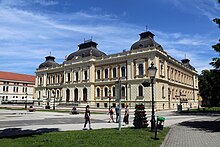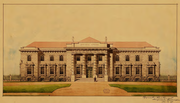Archives of Sremski Karlovci
| Архив Српске академије наука и уметности у Сремским Карловцима (Serbian) | |
 Clerical High School of Saint Arsenije building housing the archive | |
| Agency overview | |
|---|---|
| Formed | 1690[1] |
| Jurisdiction | Serbian Academy of Sciences and Arts |
| Headquarters | Branka Radičevića Square 17, 21 205 Sremski Karlovci, Vojvodina, Serbia 45°12′15″N 19°56′03″E / 45.20417°N 19.93417°E |
| Website | Official website |
The Archives of Sremski Karlovci (Serbian Cyrillic: Архив у Сремским Карловцима) in Sremski Karlovci is the first modern archive in modern Serbian history. Established by the Serbian clergy of the Metropolitanate of Karlovci, since 1949 archives are managed by the Serbian Academy of Sciences and Arts. The archive was effectively established at the time of the Great Migrations of the Serbs in 1690, during which Serbian Orthodox clergy brought books, charters of Serbian rulers, sacred inventories, ecclesiastical letters, and other documents from the Balkan regions of the Ottoman Empire to the Habsburg Monarchy.
This initial collection was expanded through correspondence conducted by Patriarch Arsenije III Crnojević and his successors with various institutions and individuals in the Habsburg Monarchy, Ottoman and revolutionary and subsequently independent Principality and Kingdom of Serbia, Russian Empire, and other countries. At the time, the town of Sremski Karlovci served as the religious, cultural and political seat of Serb community in Habsburg lands. Being the primary archive in the town, today materials preserved in its collections are crucial for studying the political, cultural, and economic history of the Serbian people in present-day Vojvodina and other parts of the former Austro-Hungary.
During the World War II in Yugoslavia, the archive was closed by the Independent State of Croatia Ustasha regime and partially damaged. Local German officers, motivated by Leopold von Ranke's historical interest in Serbian history, nevertheless ordered the archive to be secured, saving most of its documents till the end of the war.
On July 4, 1949, the Holy Synod of the Serbian Orthodox Church handed over the archive of the Metropolitanate of Karlovci and the Patriarchate of Karlovci to the Serbian Academy of Sciences and Arts for preservation and organization for scientific use for an initial period of 50 years that was twice extended in 1999 and 2009. The archive remained permanently housed in the building of the Clerical High School of Saint Arsenije.
History
[edit]Foundation
[edit]In 1683, the Ottoman Empire besieged Vienna, but was routed by an allied army that included the Holy Roman Empire led by the Habsburgs. The imperial forces, among whom Prince Eugene of Savoy was rapidly becoming prominent, followed up the victory with others, notably one near Mohács in 1687 and another at Zenta in 1697, and in January 1699, the sultan signed the treaty of Karlowitz by which he admitted the sovereign rights of the house of Habsburg over nearly the whole of Hungary (including Serbs in Vojvodina). As the Habsburg forces retreated, they withdrew 37,000 Serb families under Patriarch Arsenije III Čarnojević of the Serbian Patriarchate of Peć.[2] In 1690 and 1691 Emperor Leopold I had conceived through a number of edicts (Privileges) the autonomy of Serbs in his Empire, which would last and develop for more than two centuries until its abolition in 1912. This framework which included religious tolerance and freedom from serfdom enabled the development of religious, cultural and political institutions and life at the time when modern day Central Serbia was under the Ottoman rule. The archive's origin is linked to the Great Migration of 1690, during which Serbian clergy and people brought books, charters of Serbian rulers, sacred inventories, ecclesiastical letters, and other documents into their new center in Sremski Karlovci.[3]
Archive of the Orthodox Church in Sremski Karlovci
[edit]The new Metropolitanate of Karlovci was formally established in 1713 with the institution providing more organized protection for documents saved during the Great Migration.[4] The first inventory of the archive dates back to 1719.[5] The original minutes of the 1848 May Assembly in Sremski Karlovci that led to the proclamation of Serbian Vojvodina were preserved in the archive.[4] The building of the Clerical High School of Saint Arsenije which houses the archival collection was completed in 1902.[5] Serbian historian, Orthodox priest, academic and publisher Dimitrije Ruvarac established journal titled Arhiv za istoriju Srpske pravoslavne Karlovačke mitropolije that was published between 1911 and 1914 but was interrupted by the beginning of the World War I.[6] The journal continued his earlier work of documenting and analyzing important historical records from the Patriarchal and Metropolitan Archives in Sremski Karlovci.[6]
During World War II in Yugoslavia, the archive was closed by the Ustasha regime and partially damaged.[3] However, a German officer, inspired by historian Leopold von Ranke's interest in Serbian leader Karađorđe, ordered the archive to be secured, thereby saving most of its documents.[3] In the immediate aftremath of the World War II the building of the archive temporarily housed the Archive of Vojvodina as well.[7]
Serbian Academy of Sciences and Arts Archive in Sremski Karlovci
[edit]On July 4, 1949, the Holy Synod of the Serbian Orthodox Church transferred the archive of the Metropolitanate of Sremski Karlovci to the Serbian Academy of Sciences and Arts for preservation and organization for scientific use.[3] This agreement, which extended SANU's responsibility for the archives, was set for 50 years and expired in 1999.[8] The agreement was subsequently renewed twice, each time for ten-year periods.[8] On December 7, 2018, with the support from the Government of Vojvodina Serbian Academy opened Audiovisual Archive and Center for Digitalization at the archive in Sremski Karlovci.[9] When the third agreement between the Serbian Orthodox Church and SANU expired in 2020 the church expressed its intention to transfer religious documents back to the church while ensuring their continued accessibility for researchers.[8] This request was based on the recommendation of the Ministry of Culture and Information and the Archive of Serbia that the entire sacral fundus should be nominally transferred to the Archive of the Serbian Orthodox Church while materials related to state and administrative issues should nominally be the responsibility of the Archive of Vojvodina.[8]
See also
[edit]- List of archives in Serbia
- Archive of the Serbian Orthodox Church
- Archive of the Eparchy of Buda
- Archive of Serbia
- Archive of Vojvodina
- Historical Archive of Srem
References
[edit]- ^ "Arhiv Srpske akademije nauka - Sremski Karlovci". Tourist Organization of Vojvodina. Retrieved 19 July 2024.
- ^ Frazee, Charles A. (1969). The Orthodox Church and Independent Greece 1821-1852. Cambridge University Press. p. 6.
- ^ a b c d "Архив у Сремским Карловцима". Serbian Academy of Sciences and Arts. Retrieved 19 July 2024.
- ^ a b "SAČUVANI KORENI NAŠEG IDENTITETA: Prezentacija u Arhivu SANU u Sremskim Karlovcima". Večernje novosti. 10 February 2021. Retrieved 19 July 2024.
- ^ a b "ARHIV SANU U SREMSKIM KARLOVICIMA". Turistički Vodič Srbije. Retrieved 19 July 2024.
- ^ a b Danica Radović (13 December 2006). "Ruvarčev "Arhiv"". Politika. Retrieved 19 July 2024.
- ^ Jelić, Spomenka (27 June 1991). "Povratak zaboravljenoj baštini" [Return to the Forgotten Heritage]. Borba (in Serbian). Belgrade, FR Yugoslavia: Belgrade University Library. p. 19. Retrieved 19 July 2024.
- ^ a b c d Z. Milosavljević (5 July 2024). "ЧЕТИРИ ГОДИНЕ ОД ИСТЕКА УГОВОРА ИЗМЕЂУ САНУ И ЦРКВЕ Архивску грађу СПЦ чека оваква судбина". Dnevnik (Novi Sad). Retrieved 19 July 2024.
- ^ "SANU otvorila Odeljenje AVA i u Sremskim Karlovcima". SEEcult.org. 7 December 2018. Retrieved 19 July 2024.

